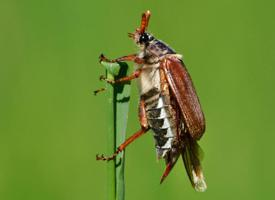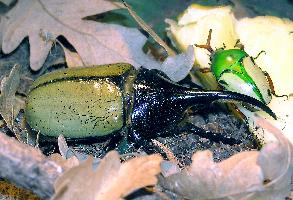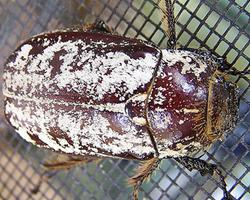
Poids et mesures
| Longueur | de 25 à 30 mm |
|---|
Description de l'animal
The Common Cockchafer, scientifically known as Melolontha melolontha, is a fascinating insect belonging to the Scarabaeidae family, which is renowned for its large and diverse group of species. Often referred to as the May bug, mitchamador, billy witch, or spang beetle, this beetle has played a prominent role in European folklore and agriculture due to its widespread presence and the noticeable impact it has on crops and vegetation.Physical Characteristics:
The Common Cockchafer is an impressively sized beetle, with adults typically measuring between 25 to 30 millimeters in length. Their robust bodies are covered in a hard exoskeleton that exhibits a reddish-brown coloration, providing some camouflage against tree bark and soil. One of the most distinctive features of the Common Cockchafer is its large, fan-like antennae, especially pronounced in males. These antennae are not just for show; they serve a critical role in sensing pheromones, enabling males to locate females even over considerable distances during the mating season. The beetle's head is relatively small compared to its body, with strong mandibles designed for chewing through plant material. Its wings are encased in a pair of hard elytra, which protect the delicate flight wings underneath and are a common characteristic of beetles.
Lifecycle and Reproduction:
The lifecycle of the Common Cockchafer is quite intriguing and spans over a period of 3 to 4 years, which is relatively long for an insect. The cycle begins when females lay their eggs in the soil during late spring, after which the larvae, known as grubs, hatch and immediately start feeding on the roots of various plants. These grubs are C-shaped, whitish in color, with a brown head and six legs, and can grow up to 40-60 mm in length. They spend the next 2 to 3 years developing underground, going through several instar stages before pupating. The pupal stage occurs in a cocoon in the soil, and by the next spring, adult cockchafers emerge to start the cycle anew.
Diet and Impact on Agriculture:
Both the larval and adult stages of the Common Cockchafer have a significant impact on agriculture and forestry. The larvae are voracious feeders on the roots of grasses and other plants, including crops such as wheat, potatoes, and other vegetables, which can lead to substantial economic losses. Adult cockchafers feed on the leaves of a wide range of trees and shrubs, with a particular fondness for oak, elm, and ash leaves. In large numbers, they can defoliate entire trees, weakening them and making them more susceptible to disease and other pests.
Conservation Status:
Despite their sometimes-destructive nature, Common Cockchafers are an integral part of the ecosystem, serving as a food source for birds, mammals, and other insects. Their populations have experienced fluctuations over the years due to factors such as pesticide use, habitat loss, and changes in agricultural practices. In some areas, they are considered pests, while in others, their numbers have declined to the point where conservation measures may be necessary to ensure their survival.
In conclusion, the Common Cockchafer is a remarkable insect with a complex lifecycle and significant ecological roles. Its presence in folklore and agriculture highlights the close relationship humans have with this beetle, underscoring the importance of understanding and managing its populations for the benefit of both natural ecosystems and human interests.
Animaux similaires
Nouvelles photos d'animaux
Top 10 des animaux
- Dolphin gull (Leucophaeus scoresbii)
- Diana monkey (Cercopithecus diana)
- Moustached guenon (Cercopithecus cephus)
- Galápagos tortoise (Geochelone nigra complex)
- Russian tortoise (Testudo horsfieldii)
- Japanese macaque (Macaca fuscata)
- Stone loach (Barbatula barbatula)
- Greek tortoise (Testudo graeca)
- Common flying dragon (Draco volans)
- Colossal squid (Mesonychoteuthis hamiltoni)


